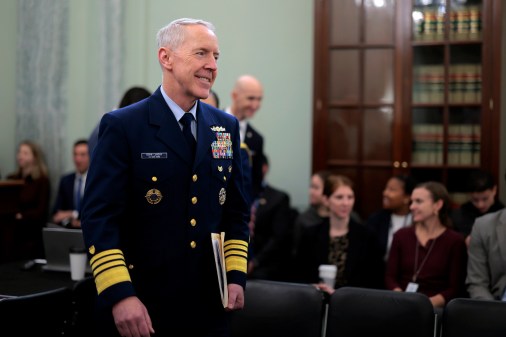Army Cyber making moves to improve readiness

The Army has sought to improve the training of cyber mission force members it provides to U.S. Cyber Command such that they require less on-the-job instruction.
Since the creation of the cyber mission force — the teams each military service is responsible for providing a set number to Cybercom to employ for operations — over 10 years ago, personnel often wouldn’t get all the training they would need at their schoolhouse prior to arriving at their operational units. Rather, digital warriors would get additional on-the-job training upon arriving at their unit. This was a contributing factor to readiness issues that have plagued the cyber mission force across all the services.
Recently, however, Cybercom’s commander, Gen. Timothy Haugh, has noted marked improvements in readiness levels.
Army Cyber Command is trying to move that training to the left as part of its efforts to improve the preparedness of the forces it provides to Cybercom.
“Some of the other things that Gen. Haugh has been talking about, like training to the left, so that more of the soldiers in the CMF when they come out of the schoolhouse don’t require as much or any additional training in order to perform their work role,” Lt. Gen. Maria Barrett, commander of ARCYBER, said in an interview. “The Army, a while ago, aligned its coursework to do … all of the 1000-level tasks and as many of the 2000-level tasks as it could in order to do that. It just didn’t make any sense where we have the majority of the cyber forces in the CMF, why would we insert unique service requirements into the schoolhouse training? First take care of the joint requirements. There is a very strong alignment between the curriculum in the [Cyber Center of Excellence] and the requirements that Cyber Command has put out.”
Operational commanders who receive personnel from the services have to balance their operations with managing the workload directed at training, which is a difficult task, Barrett noted. They don’t want to focus so much on individual training, but rather, the collective training of their respective teams as a unit. She said going forward, they want to spend as little time as possible focusing on the individual training at the operational command and focus more on collective training or developing proficiency beyond basic.
Barrett explained that there are many factors that go into readiness and remedies for deficiencies, noting there is no “silver bullet.”
“There’s the schoolhouse to be considered, there’s the advanced training, there’s the number of ops that we do, there’s the number of trainers to sign off on the training. A whole bunch of things go into the readiness picture,” she said.
Army Cyber is continuing other efforts to improve the preparedness of its forces, some of which were initiated under Paul Nakasone, the previous Cybercom commander, according to Barrett.
Those include special pay for military personnel and civilians, something Haugh has lauded previously, and retention bonuses. Barrett explained that direct hiring authorities with Cyber Excepted Service have also improved readiness.
The Army will be doing five-year tours for cyber mission force members and enablers that perform intelligence, fires, or any other support for those teams.
“If your training pipeline, or some of the unique aspects of doing that discipline in cyber is a one to two years of training and certification, now we get three to four years on the backside of developing proficiency in those disciplines. I think that would be a huge win,” Barrett said.
This leads to deep proficiency in the work roles, something Haugh has talked about realizing for the force.
“It isn’t just about having a particular fill rate, or having people trained at a basic level. We need people at a senior and master level in order to really face the challenges that we think we’d be faced with in the future,” Barrett said.
Army Cyber is looking to instill these readiness fixes, all while continuing to build more teams. In the fiscal 2022 budget, Cybercom proposed and was eventually approved for a phased approach to add 14 additional teams beyond the original 133, adding teams for the first time since the cyber mission force was created. The Army is building four teams over a five-year period and has already seen two such teams achieve initial operating capability. Those teams are now supporting the cyber mission force, marking a significant milestone in enhancing the command’s cyber capabilities, according to an ARCYBER spokesperson.
“That’s a little bit of the challenge of increasing readiness across the rest of the CMF while you’re also growing teams, is we’ve been able to balance that, because that’s very difficult to increase your readiness while you’re growing at the same time. But the teams are on schedule in terms of where we expected them to be from an IOC and [full operating capability] standpoint,” Barrett said.
Regarding the employment of her cyber teams, Barrett declined to offer any specifics regarding operations in the Middle East, but she said they’ve been busy since Oct. 7, 2023, when Hamas’ attack on Israel ramped up tensions and conflicts in the region.
Forces under Cybercom are employed for operations through what’s known as Joint Force Headquarters-Cyber. Each service cyber component commander is also the commander of a Joint Force Headquarters-Cyber and is responsible for operations for assigned combatant commands. For example, JFHQ-C Army is responsible for operations in U.S. Northern Command, Africa Command and Central Command, which covers the Middle East.
Hamas’ attack last year set off a new round of turmoil in the volatile region, which has included an all-out Israeli assault against the militant group and its backers such as Iran and its proxies to include Hezbollah in Lebanon. Additionally, the Houthis — a group backed by Tehran that has controlled portions of Yemen, including the capital, since 2014 — have been attacking U.S. military and commercial ships transiting the Red Sea.
“I do think the volatility of the region is something that we continue to keep our eye on. It is incumbent upon us to deliver both Gen. Haugh and [Central Command commander] Gen. [Michael] Kurilla as many options as possible to kind of try to reset that region. That’s first and foremost, I think. That’s what we’re trying to do is give them options where we can perhaps deescalate, make it more safe to transit the Red Sea,” Barrett said. “That’s what we’ve been really focused on doing.”






